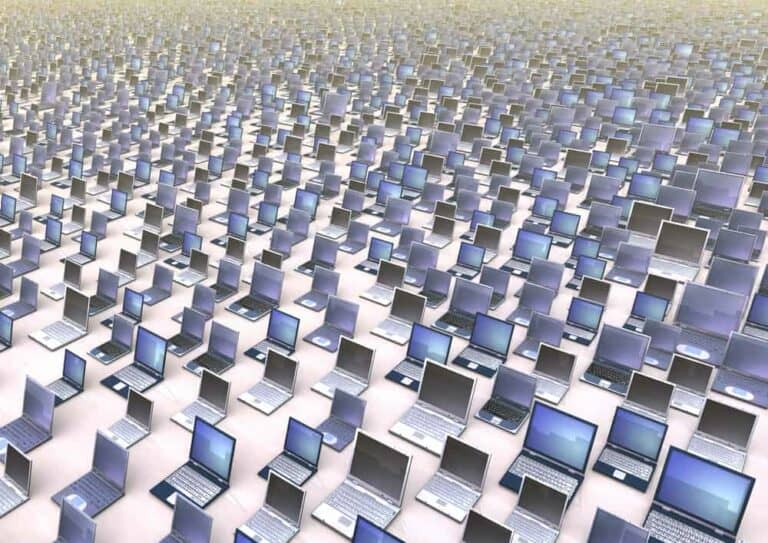PC sales figures reached a new low in 2023. Business and residential customers alike continue to put off replacing their existing machines. Could the rise of the AI PC provide redemption for Lenovo, HP, Dell and others?
Gartner leaves no room for doubt: 2023 was the worst year for the PC industry of all time. The market shrank 14.8 percent in 12 months. Dell COO Jeff Clarke put it this way during the quarterly earnings presentation: “Fiscal 2024 was one of those years that didn’t go according to plan.” (Dell’s fiscal 2024 ran between April 2023 and March 2024, ed.) Dell’s PC shipments fell 19.5 percent to 40.2 million. HP (-4.5 percent) and market leader Lenovo (-13.5 percent) also presented worrying sales figures.
All PC makers predict a better 2024. In this they are not alone: several market researchers have argued that AI can be the driver of growth. When it comes to servers, AI is already considered a driver of success. Dell, for example, faces a wait of more than six months to get suitable hardware to customers.
Real improvement on the way
The devastating figures regarding 2023 already contain a sign of hope, according to Gartner. For example, the entire PC market grew 0.3 percent again in Q4 2023. It could hardly get any worse for the PC industry, but the two years of decline seem to have finally reached its low point.
Canalys pointed out late last year that the PC market in 2024 will be helped by several factors. One of them has nothing to do with AI: namely, it is simply time for many users to upgrade their PCs again. Enterprise environments still running Windows 10 have until Oct. 14, 2025 to do so without purchasing an expensive Extended Support Updates package. So improved PC sales will happen in part without actual innovation.
It gives Windows 11 a chance to grow, which from Microsoft’s perspective is about time. Regardless, according to Canalys, the Windows refresh will create a lot of traction within the PC industry. As an OS, it seemed to have to make way for Windows 12 for a while, but nothing could be further from the truth. With Windows 11 24H2 appears an AI-focused operating system that makes a PC upgrade attractive. After all, new AI PCs tend to have specific hardware on board that can efficiently run these new kinds of workloads, as is true of Intel Core Ultra. To make the most of the new capabilities, new PCs should be attractive to both business and residential markets. Canalys does note the re-embrace of ARM architecture for Microsoft will not immediately drive better adoption within enterprise environments.
Problems remain
That PC sales are slowly getting back on the rise does not mean that all the problems have been fixed. For example, component costs continue to go up, with a shortage of capacity at chip manufacturers and rising costs for RAM and NAND flash on the horizon. The latter has largely to do with the fact that supply has long been well beyond demand, so there is now a price correction due to slowed supplies. All of these are costs that can be passed on to the customer, inhibiting sales.
It is also true that hardware advances apart from AI are a lot slower than before. Moore’s Law has been slowing down for years, so the same performance jumps will now cost more money than before. Combine that with challenging macroeconomic conditions and geopolitical tension with China, and it results in a host of challenges to selling PCs at a profit.
Innovative solutions (which sometimes backfire)
The trend that users want to keep their PCs longer and hardware is less likely to improve also presents opportunities. Sustainability has increasingly become a focus for manufacturers. This leads, among other things, to recycled plastic that ends up back in new products and responsible cardboard packaging. However, there is one aspect to which PC makers can also contribute: refurbishing old machines.
We’ve written about HP’s refurbish program before (see link below). It targets business PCs that traditionally go through a predictable cycle. HP handles the refurbish process of computers that can still run, but are no longer brand new. This not only reduces the pressure on the environment, but also gives the PC maker a chance to make another profit on the same device. Even though the revenues for such machines are small, the low costs compensate for that. In addition to PCs, HP also plans to launch refurbishment programs for printers and collaboration hardware.
Tip: HP launches refurbishment program for business PCs
Lenovo is also getting into the refurbishment market, The Register reported. Not only PCs, but also servers will be part of the yet-to-be-established initiative. Only accredited partners can sell the refurbished hardware. The fact that several vendors are moving in this direction indicates that it could be lucrative. Either way, it creates additional revenue from existing equipment that users hope to use longer and longer.
These practices could prove beneficial, but everything hinges on the software. We’ve know for some time that Microsoft would eventually discontinue Windows 10. However, it is not possible for many users to upgrade to Windows 11 on their current machines. That, more than other factors, will cause otherwise capable hardware to end up on the scrap heap. Not a positive development for the refurbishment programs of PC vendors perhaps, but a positive one for the demand for new hardware. In that area, it seems consumers will eventually be forced to opt for a new desktop or laptop after all. That ensures that the PC market will emerge from its lowest point this year, more than AI will enable them to do.
Also read: Windows 11 24H2 eliminates need to reboot after update
